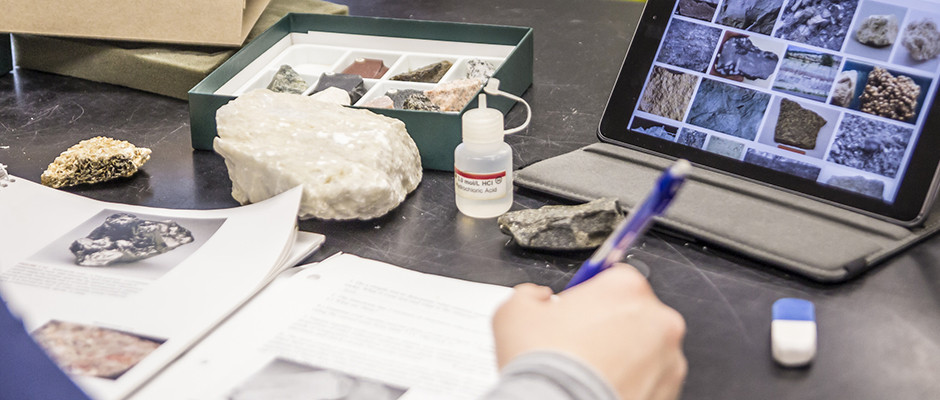What you’ll learn
Earth sciences provide the understanding to deal with tough public questions concerning resource development and land use. You’ll learn to understand natural resources and systems crucial to solving resource problems. You’ll identify the common rock forming minerals and typical ores and gems and identify rock types and the structures they form. As well, you’ll learn to read maps and to judge the 3rd dimension of the subsurface.
Geoscience courses at Camosun are all core courses at universities and required background for professional registration as a geoscientist with A.P.E.G.B.C. Whether you are hoping to satisfy personal curiosity about what the Earth is made of and how it works or career bound, Camosun is a good place to start.
Careers in Earth Sciences
Professional Geologists with degrees in Earth Science find and develop all the resources which cannot be grown or renewed. Growing population drives the demand for more, minerals, hydrocarbons, groundwater resources to be discovered, delineated, evaluated and produced along with environmental remediation to put the forest or lake back once complete.
Basic degrees allow work in mapping and evaluating for hardrock mineral exploration, softrock exploration for oil, gas, coal and water resources. You’ll do development work on existing fields and mines, as well as wellsite geology, core logging, and geophysics. You’ll be involved in environmental assessment and remediation. You’ll also provide geohazards assessment for projects: roads, dams, bridges, pipelines, tunnels, mines, cities and towns.
Specialists in slope stability, coastal morphology, tsunamis, hydrogeology, earthquakes and volcanology help us live with active landscapes. Geoscientists need to critically observe, cleverly interpret and carefully deal with all of the incredible complexities the Earth presents or that living environments and ecosystems require.
These careers are becoming more in demand and the desire for skilled and knowledgeable professionals is needed all the time. As long as we continue to need more wires, pipes, roads, bridges, wind turbines, solar panels, better solutions to old problems and environmental remediation there is a growing job market and careers for the foreseeable future.
Deep Time – A Big Picture Geological concept
The rock record contains all we can ever find out concerning the history of the Earth. Because geological features, like deltas from rivers or glaciers from ice ages, occur for common reasons, we can use them as a key to the past.
Physical, chemical, biological and geological systems all interact at many levels to give rise to many unique environments, as broad as oceans or ice caps or as narrow as a strip of beach or a stream channel. While time is vast, ~4.6 billion years, the similar events and features tend to recur. Sea levels tend to rise and fall with daily to monthly tides or with Milankovitch cycles many tens to hundreds of thousands of years in their span. Sea levels rise and fall and occur over millions of years for tectonic causes such as new mid-ocean ridges or deep sea trenches, as well as for climate changes (ice ages and interglacials).
Against this backdrop of shifting physical environments, organisms and whole ecosystems need to adapt, migrate or die out to be replaced by newer forms. Biological evolution and revolution has even affected climate by changing Earth’s atmosphere many times since the Archean. The sediments of the present and past ocean basins record what past climates and seas were like. We can even track their changes to say what might come next and in a sense be able to scientifically predict the future.
Contact information
Victoria Conservatory of Music
General Questions? We want to hear from you!
John Lee - Department Chair, Chemistry & Geoscience
Contact Admissions for information about applying to Camosun.
